In the Name of God, Most Gracious, Most Merciful
Reptiles
Reptiles I
Snakes & Lizards
[24:45] And God created every living creature from water. Some of them walk on their bellies, some walk on two legs, and some walk on four. God creates whatever He wills. God is Omnipotent.
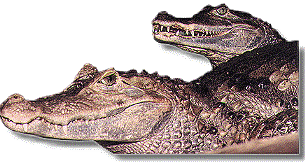 This verse clearly refers to all of God's creatures but it specifically covers reptiles. Reptiles are a class of animals, made up of snakes, lizards, turtles, crocodilians and tuatara. The last is a rare, lizardlike reptile that lives only on a few islands near New Zealand. They are called living fossils since all the rest of their order is extinct, having died out millions of years ago. Why they survive, no one knows and little is known about them. Much, however, is known and written about the other reptiles because we interact with them regularly, and like all of God's creations there is much that is fascinating. There are more than 2500 species of snakes, about 2500 species of lizards, 250 different kinds of turtles, and about 22 different crocodiles.
This verse clearly refers to all of God's creatures but it specifically covers reptiles. Reptiles are a class of animals, made up of snakes, lizards, turtles, crocodilians and tuatara. The last is a rare, lizardlike reptile that lives only on a few islands near New Zealand. They are called living fossils since all the rest of their order is extinct, having died out millions of years ago. Why they survive, no one knows and little is known about them. Much, however, is known and written about the other reptiles because we interact with them regularly, and like all of God's creations there is much that is fascinating. There are more than 2500 species of snakes, about 2500 species of lizards, 250 different kinds of turtles, and about 22 different crocodiles.
SNAKES
 Snakes live in most of the warm places in the world, ranging from harmless to deadly, from plain to colorful, from a tiny four inches to over 30 feet in length. Snakes do not have a good reputation. Biblical references to snakes are very negative since it's a snake which tempted Eve to eat the apple and thus caused the downfall of mankind. And when Moses' staff is turned into a serpent, he harbors fear. Plus, we have some pretty negative expressions in the English language taken from reptiles and reptile behavior. We call a cheating, conniving person a "snake in the grass"; a cowardly person "crawls on his belly"; a very callous action is "in cold blood," even the dictionary definition of snake includes: "a treacherous person." A snake pit is a mental institution or any very dangerous place. But interestingly, for some cultures, the snake represents re-birth and renewal, perhaps because of its ability to shed its skin and thus start over.
Snakes live in most of the warm places in the world, ranging from harmless to deadly, from plain to colorful, from a tiny four inches to over 30 feet in length. Snakes do not have a good reputation. Biblical references to snakes are very negative since it's a snake which tempted Eve to eat the apple and thus caused the downfall of mankind. And when Moses' staff is turned into a serpent, he harbors fear. Plus, we have some pretty negative expressions in the English language taken from reptiles and reptile behavior. We call a cheating, conniving person a "snake in the grass"; a cowardly person "crawls on his belly"; a very callous action is "in cold blood," even the dictionary definition of snake includes: "a treacherous person." A snake pit is a mental institution or any very dangerous place. But interestingly, for some cultures, the snake represents re-birth and renewal, perhaps because of its ability to shed its skin and thus start over.
With all the amazing variety of other animals, why did God create something that has to walk on its belly? It, of course, has a very important place in the food chain-eating large numbers of rodents, lizards and such, and being eaten by others. But more importantly, like all the other variety, I think it's for us to study and marvel at. Part of the proof of God's creation.
Snakes are fascinating in that, as God says, they walk on their bellies, with amazing agility. There are actually four quite different types of locomotion. The most frequently used method is the simple, undulating crawl, which is called the serpen-tine method. The snake pushes against the ground and flows smoothly forward, using muscles specifically designed for this. Heavier-bodied snakes may use a method called caterpillar where the skin is moved forward and backward by strong mus-cles, and the broad belly scales grip the ground, moving the snake forward in a straight line.
Several desert-dwelling species use sidewinding to move on loose sand. In this method the snake rolls its body sidewise along the ground in a looping motion. The fourth method is known as concertina, because the body is alternately stretched out and pulled together as the snake moves from one anchor point to another. The concertina is used in crossing smooth surfaces and in climbing. So they don't actually walk, but they can move right along, some going as fast as 8 miles per hour.
Also fascinating are the adaptations God has provided which allow a snake to eat. You have to wonder how something that long and narrow can eat at all, let alone eat an animal that may be many times wider than the snake's mouth. Although they have teeth, snakes cannot tear apart an animal and eat it in pieces. It must swallow its food whole, so the snake must actually decide whether or not he can get it down. Snakes eat everything from ants to rabbits, frogs, lizards, mice and eggs. Large snakes like anacondas and pythons may take down deer, antelope, crocodiles and even humans. Most normal sized meals are swallowed easily and quickly, but a truly large meal may require several hours to consume and weeks or months to digest. A python may eat only once a year.
God has provided several adaptations to make eating possible for snakes. A special hinge in the jaw allows the mouth to open wide enough and rows of teeth pointed back pull the food in. While swallowing very large animals, the snake would not be able to breath so God provided an additional organ, a tracheal lung, around the windpipe which allows lung function to continue in spite of the pressure, and the windpipe itself can be pushed outward past the animal being swallowed to allow air in.
With over 2500 species there is great variation in color, size and of course, how they interact with humans. One of the more deadly is the black mamba of Africa which grows to 14 feet in length and moves through trees as easily as through the tall grass. It can hold its head up to 20 inches off the ground even as it moves. It's considered the fastest snake in the world and has a very deadly bite, with 100 % mortality. The victim dies very quickly, within minutes.
Cobras are also virulent with 30,000 deaths reported annually in China alone. They hang around crumbling ruins and lurk in roofs of huts. They're waiting for rodents and lizards, but if disturbed by a human they will react defensively. They strike swiftly and accurately or they spit venom several feet in front of them. The venom acts as an anesthetic so the victim feels no fear, no anxiety, no pain, almost as if hypnotized.
Rattlesnakes also have deadly venom. The young are born live, rather than from eggs, and they are born ready to strike with venom sacks full. In fact, the bite of a young rattler may be more potent than an adult's, plus multiple bites may occur as a litter of as many as 20 emerge. Emulating the rattlesnake is the harmless gopher snake. God has provided them with similar coloration and they mimic the behavior-flattening their heads, hissing, and rattling their tails (even though they don't have rattles). Most predators don't take any chances and leave them alone.
Snakes come in so many colors and wonderful patterns of spots, stripes and bands. When we study them, we see that they are one of God's miraculous creations. They should be respected not reviled.
LIZARDS
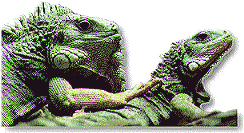 Lizards too come in a huge variety of shapes and colors. Most lizards walk on all four legs, but there are legless lizards (which are not snakes) and there's the basilisk lizard which, when running very fast, will get up on two legs. He can even race across the surface of water on his two back legs. There's also a lizard that "flies"-it opens out flaps of skin along its sides as it leaps off a tree branch and glides from tree to tree.
Lizards too come in a huge variety of shapes and colors. Most lizards walk on all four legs, but there are legless lizards (which are not snakes) and there's the basilisk lizard which, when running very fast, will get up on two legs. He can even race across the surface of water on his two back legs. There's also a lizard that "flies"-it opens out flaps of skin along its sides as it leaps off a tree branch and glides from tree to tree.
The largest lizard is the Komodo Dragon which may be ten feet long and weigh over 350 pounds. The Komodo Islands of Indonesia are a dangerous place, with more deadly snakes, scorpions and poisonous spiders than anywhere else on earth. Earthquakes, tidal waves, and monsoon rains occur over half the year, followed by wildfires in the dry grass the other half, and all around are active volcanoes. It's no surprise, then, that a huge monitor lizard evolved here and was referred to as a dragon. It seemed so fantastic that early accounts were discounted as myth until 1912, and they are still not a well-understood animal.
Komodo dragons live 50 years or more, and they're considered quite smart. To hunt, they lie in ambush, remembering a place they were successful before and preparing their hiding place hours in advance. When a herd of deer passes by the hideout, the dragon lunges out with great speed to knock the deer over. If they miss, they can't run down the prey so they just go back to wait some more. If they're successful, they will take several weeks to digest the meal, probably eating only about 12 meals a year.
Smaller but still large for a lizard is the Gila Monster, the only venomous lizard of North America and one of only two in the world. This desert dweller moves slowly, feeding on eggs laid on the ground and small rodents. Since food and water are sometimes scarce in the desert, God has provided by allowing him to store fat in his tail and live off that resource in lean times.
Another desert dweller is the horned lizard or "horney toad." Their specific adaptations include a dull color and a flat body which makes them difficult to see, and horns and spiny scales which make them difficult to swallow. In addition, a unique defense mechanism allows the horned lizard to squirt blood from its eyes when severely threatened.
The smallest lizard in the world is the British Virgin Island gecko, which is less than half an inch long. Geckos are inter-esting little creatures, one of few lizards that vocalize-they emit a high squeak. They can climb anything, even walk on ceilings, because they have special toe pads which contain microscopic hooks for hanging on. Their tails detach easily when grabbed by a predator and will continue to wiggle for several minutes, allowing the gecko time to get away. They regenerate a new tail within a few weeks.
[16:13] And (He created) for you on earth things of various colors. This is a (sufficient) proof for people who take heed.
Lizards are colorful indeed. They come in all shades of green and are adorned with yellows, oranges, and reds, even blue. And if that weren't enough, there's the chameleon that can change colors at will. Chameleons are also the "sharpshooters of the lizard kingdom." They can move their eyes independently so they can keep one eye on prey as they sneak up on it and use the other eye to watch out for predators. When they get close they focus both eyes on the prey giving them an excellent binocular view. The tongue is as long as the body and tail combined and it sits rolled up in the mouth. When they let it go with a lightning strike, they are incredibly accurate. And the tip is large and sticky so they zap their prey and draw it back into their mouth.
Snakes and lizards both play an important part in preserving the balance of nature. They eat large numbers of insects and rodents, which make them beneficial to man. Their variety and their fascinating characteristics make them another proof of God's creation.
[45:3-4] The heavens and the earth are full of proofs for the believers. Also in your creation, and the creation of all the animals, there are proofs for people who are certain.
Reptiles II
Turtles
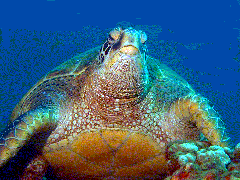
Generally in nature, an animal must seek shelter from bad weather or from a threatening situation. Imagine a creature carrying its shelter or its house with it wherever it goes. When threatened, it simply retreats into its house and locks the door. That's essentially how turtles live their lives. The turtle's shell is a remarkable feat of natural engineering, a protective gift from God. The shell has two parts?the carapace, the upper section and the flat belly section called plastron. They are connected by bony bridges leaving gaps for the head, tail and four legs. The tur-tle's vertebrae and ribs have actually become an integral part of the carapace and do not move separate from the shell. When the turtle withdraws into this shell, it's almost impossible for a predator to get at it.
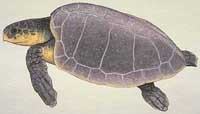 The shell accounts for about one third of the weight of a turtle, yet most turtles are agile, strong walkers or swimmers and many climb with great ease. They have developed strong legs, especially in giant species, like the Galapagos tortoise which travels great distances, although slowly. They could carry the weight of a man on their back and keep right on going. The tortoise travels about 4 miles a day. On the other hand, sea turtles have devel-oped flipperlike legs and sleek shells. They swim at about 20 miles an hour. The distance a sea turtle might travel in one hour would take a week for a tortoise to cover.
The shell accounts for about one third of the weight of a turtle, yet most turtles are agile, strong walkers or swimmers and many climb with great ease. They have developed strong legs, especially in giant species, like the Galapagos tortoise which travels great distances, although slowly. They could carry the weight of a man on their back and keep right on going. The tortoise travels about 4 miles a day. On the other hand, sea turtles have devel-oped flipperlike legs and sleek shells. They swim at about 20 miles an hour. The distance a sea turtle might travel in one hour would take a week for a tortoise to cover.
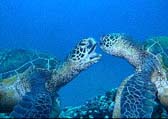
Turtles are ancient life forms. The earliest fossils recognized as turtles date from the Triassic period, about 200 million years ago. Turtles were in existence prior to the emergence of the great dinosaur groups and survived the demise of the dinosaurs, continuing to adapt and flourish. Turtles occupy almost every imaginable habitat-woods, ponds, rivers, lakes, marshlands, prairies, deserts and the open ocean, and they eat food as varied as insects, tender seagrasses, carrion, fruit and fish.
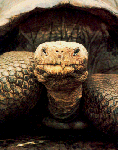 Turtles have great similarity yet great variation as well. The Galapagos tortoise evolved on islands with no predators and little competition. They grow very large-500-600 pounds-and live 100-150 years. Desert tortoises are much smaller. They eat cactus fruit and desert grasses and because of their environment, God has given them adaptations to be able to survive without water. They get the moisture they need from the food they eat.
Turtles have great similarity yet great variation as well. The Galapagos tortoise evolved on islands with no predators and little competition. They grow very large-500-600 pounds-and live 100-150 years. Desert tortoises are much smaller. They eat cactus fruit and desert grasses and because of their environment, God has given them adaptations to be able to survive without water. They get the moisture they need from the food they eat.
The pancake tortoise of Africa has a flat, soft shell, instead of the hard dome common to most turtles. It looks sort of like someone dropped a frying pan on him. This allows him to easily climb rocks and lie under them. When threatened, he will wedge himself into a rocky crevice and then inflate his body so he's almost impossible to pull out.
The red toad-headed turtle with its brilliant red head is an example of the variation in bright and beautiful colors. Various beautiful design patterns on the shell show God's wondrous creation. These include map turtles, so named because of the intricate patterns of yellow lines that actually look like lines on a topo map; the radiated tortoise of Madagascar has yellow circles with lines radiated out from them; and the leopard tortoise of Africa whose shell is covered with distinctive and beautiful yellow spots.
 One fascinating turtle species is the alligator snapping turtle, which may grow to 200 pounds. He lives on muddy river bottoms, sitting quietly with his brown shell blending with the mud. He keeps his mouth open and wiggles his tongue which is a bright pink. Like a lure, this attracts fish which swim right in and the turtle simply snaps its mouth shut. They may move no more than a few feet their whole lives.
One fascinating turtle species is the alligator snapping turtle, which may grow to 200 pounds. He lives on muddy river bottoms, sitting quietly with his brown shell blending with the mud. He keeps his mouth open and wiggles his tongue which is a bright pink. Like a lure, this attracts fish which swim right in and the turtle simply snaps its mouth shut. They may move no more than a few feet their whole lives.
Tortoises live almost exclusively on land. Many turtles move between land and water. Sea turtles spend virtually their whole life in water. The female comes out to lay eggs and she will return to the very beach where she was hatched. The whole process is truly amazing. She comes on shore, usually at night, and digs a nest into which she lays up to 100 eggs. She buries the eggs and leaves. As the embryo grows into a fully developed hatchling, the shell that has offered nourishment and protection becomes a kind of prison from which the baby turtle must escape. God has provided an "egg tooth," actually a horny projection located on the tip of the snout (which disappears as the turtle grows). The tiny hatchling uses it to pierce its shell, then pulls it apart with his forelimbs. All eggs in a nest hatch at virtually the same time and they use that community spirit in order to escape from the nest. Experiments with single eggs show that few break free on their own. Together the baby turtles scrape down the walls and ceiling of the nest and instinctively climb upward till they break free.
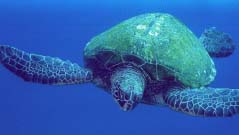
Then these hatchlings, only a couple of inches long, know that they must scramble for safety, perhaps a hundred yards or more across the open beach to the sea. And it's not just the hundred-yard dash that's difficult; predators of all kinds are waiting-birds, dogs, skunks and others seem adept at knowing where nests are and when they will hatch. Only a fraction make it to the sea and even then they are easy pickings for large fish and sea gulls.
Little is known of the first year of wild hatchlings. They simply disappear from sight, going weeks without food if necessary and struggling to escape predators of all kinds. Those that survive to adulthood will spend their lives, perhaps 50 years, swimming around in the open ocean.
The male turtles may never leave the ocean their whole life; the female only to lay eggs. We do not understand how turtles, migrating over great stretches of open ocean, find their way around. How does the female green turtle find her way back to the beach where she was hatched decades before? "The feat of locating Ascension Island, barely seven miles across, after negotiating 1400 miles of open ocean, by an animal that is hopelessly myopic when it raises its eyes above the level of the water, seems little short of miraculous." And it is miraculous, God's miracle.
 One marine turtle, the Kemp's ridley, the smallest, rarest and most endangered of all sea turtles, has unusual nesting behavior. Unlike most sea turtles which nest individually, the Kemp's ridley all come to the same location, a remote beach in Mexico, gather offshore and then swarm onto the beach together-perhaps 40,000 strong. Until the 1940's this event, known locally as "arribada", was a well-kept secret. Natives used it as a way to obtain meat and eggs. Once it became common knowledge the turtles were exploited nearly to extinction. Today the Mexican gov-ernment patrols the beaches with armed guards during arribada, but in recent years only about 400 females come ashore to nest each season, one percent of the number just 50 years ago.
One marine turtle, the Kemp's ridley, the smallest, rarest and most endangered of all sea turtles, has unusual nesting behavior. Unlike most sea turtles which nest individually, the Kemp's ridley all come to the same location, a remote beach in Mexico, gather offshore and then swarm onto the beach together-perhaps 40,000 strong. Until the 1940's this event, known locally as "arribada", was a well-kept secret. Natives used it as a way to obtain meat and eggs. Once it became common knowledge the turtles were exploited nearly to extinction. Today the Mexican gov-ernment patrols the beaches with armed guards during arribada, but in recent years only about 400 females come ashore to nest each season, one percent of the number just 50 years ago.
Turtles through myth and legend were generally regarded as symbols of strength, stability, benevolence and wis-dom. We generally like turtles, unlike most reptiles. Yet, we kill them for their shells and take away their habitats, leave many species on the brink of extinction. We need to appreciate these creatures of God, remembering Verse 11:6 There is not a creature on earth whose provision is not guaranteed by God. And He knows its course and its final destiny. All are recorded in a profound record.
[42:29] Among His proofs is the creation of the heavens and the earth, and the creatures He spreads in them. He is able to summon them, when He wills.
REPTILES III
CROCODILIANS
 Of all reptiles, the most feared and perhaps least well known are the crocodilians, which includes 22 species of crocodiles, alligators, caimans and gharials. I knew almost nothing about them, except how fearsome they look-especially when you're sitting in a canoe and see one on the shore (that happened for me in Florida a few years ago). I learned a lot of fascinating things about these creatures of God. They've been around about 200 million years. They, like the turtles, were contemporaries of the dinosaurs. As primitive as they look, they are actually the most advanced of all reptiles, and are in fact more closely related to birds than to lizards. They have a more efficient circulatory system; they are more intelligent; and they are way more attentive of their young.
Of all reptiles, the most feared and perhaps least well known are the crocodilians, which includes 22 species of crocodiles, alligators, caimans and gharials. I knew almost nothing about them, except how fearsome they look-especially when you're sitting in a canoe and see one on the shore (that happened for me in Florida a few years ago). I learned a lot of fascinating things about these creatures of God. They've been around about 200 million years. They, like the turtles, were contemporaries of the dinosaurs. As primitive as they look, they are actually the most advanced of all reptiles, and are in fact more closely related to birds than to lizards. They have a more efficient circulatory system; they are more intelligent; and they are way more attentive of their young.
Crocodilians inhabit North America, Central America, South America, China and Southeast Asia, Africa, Australia, India, Pakistan and many Pacific Islands. The Indopacific Crocodile is the largest reptile living. It reaches 23 feet or more, weighing maybe a ton. Even the smallest croc, the dwarf crocodile of Africa, is about 6 feet long.
There's a lot that's interesting about the way they care for their young. The female makes a nest, lays eggs-it varies from species to species, but anywhere from 20 to 80 eggs-and covers them with mud and plant material. Then, unlike other reptiles, she stays close by. In some species even the male stays around for protection. When the young crocs are ready to hatch they begin to make noise inside the eggs. She will dig into the nest and take the eggs one by one in her mouth. She rolls them gently back and forth until the shell cracks. She then takes the tiny crocs down to the water-she can carry up to 20 at a time in her huge mouth. They will then stay close together for weeks or months. Some even remain in family groups for years.
Despite all this attention and care, mortality rates are as high as 90% in the first year. Many things happen. The female doesn't sit on the nest like birds so climatic conditions will affect the eggs. If it's too cool, too wet, or too hot, the eggs will not develop. In many cases, the whole clutch will perish.
Predators hang around even though the female is nearby, because croc eggs are a prime source of food for so many other animals. Many female crocs fast while standing guard but they do need water. Predators wait for her to go get a drink. Lizards, birds, raccoons, foxes and monkeys all raid the nests. If the eggs survive, the hatchlings face a lot of dangers, as the tiny crocs also are food for all kinds of predators-frogs, snakes and turtles, herons, raccoons and other mammals. Interestingly, if the croc survives to adulthood, all these predators will become his prey.
[53:45] He is the One who created the two kinds, male and female.
[75:39] He made it into male or female.
The most interesting thing about crocodilian offspring is that it is truly God who decides the male and female. We know that's true for everything, but in this case, the sex of the offspring is determined by temperature, not by chromosomes. When the egg is laid, its sex has not been decided. Temperatures during the first half of incubation will determine the sex of each individual. In the American alligator, high temperature creates males, low temperature makes females, but in the crocodile high and low temperatures create females, only intermediate temperature makes males. A small difference in temperature-One or two degrees-makes a marked difference in sex ratio. Within a nest, all may be the same sex or the temperature may vary enough to have all females in the lower layer of eggs and all males above or vice versa. In American alligators, those who build their nests in cool marshes will have all females; those who nest in warm mounds will have all males. Muggers of India nest at different times throughout the season, in fact a single female may nest twice. Those that nest early in the season will produce mostly females; those who nest later when the soil temperature has risen will have mostly males. I think this is fascinating. God is the One who makes each of these creatures into male or female.
Crocodilians are well adapted as predators. When in the water, they swim casually using a gentle "s" motion of their tail to propel them. They stay almost completely submerged with only nostrils and eyes above the water, looking like a small log. They may smell prey on shore from a great distance and swim closer, with a final lunge that may carry the croc several times its own length up onto the beach. If it gets a hold of any part of the animal, it will win. It will pull the victim into the water where it drowns. If it doesn't get a hold, it may knock the animal over with several blows of its head. In addition, crocs will sneak up on a wading bird and as it takes off, the croc can leap out of the water almost vertically. And if large game isn't available, the croc will use its tail to sweep schools of fish toward its mouth and gobble up as many as possible.
As to diet, one book said adults will eat "anything they want." They regularly take down mammals that come to drink at the water's edge, like gazelle, even zebras and wildebeest. They can crush the strong bony shells of turtles. They may try to take a hippo or elephant calf but the mother will be protective and have been known to crush crocs. The Nile crocodile has a reputation as the number one killer of beast and humans on the African continent. A crocodile wouldn't go out of his way to find a human victim but they will take anything presented to them. A horrible incident from World War II happened off the coast of Burma. A thousand Japanese soldiers, fleeing the allied advance, tried to cross a mangrove swamp at night. British troops reported the horrifying sounds, and at dawn only about 20 were found alive. The crocs were simply following their instincts and taking advantage of an easy meal.
Had I known all this, I might not have been so blasé in my encounter with the alligator in Florida. My sister and I were canoeing and we knew that alligators were present. The canoe rental place had basically said not to worry, just keep paddling. We heard a huge sound and both of us saw the alligator at the same time. Fortunately it was at least 50 feet from us, on shore, but looking our way. Everything stopped, including my heart. It was a typical American alligator, about 8 or 9 feet long, and I felt incredibly small and insignificant. I said Bismillah and started to breath again and we kept paddling. When we came back the alligator was gone.
This was a great gift. The opportunity to see one of God's amazing creatures in its natural habitat. I'm thankful that I don't live where I have to wash my clothes in the same river where crocodiles lie in wait, but I'm also thankful for the opportunity to see one and know a little bit of that fear and awe.
Reptiles are awesome creatures, nearly 6000 different species, so many variations. They walk on their bellies, they walk on two legs, they walk on four. They are part of God's intricate interwoven plan on this earth. We like them or we fear them, but we need to appreciate them. For their part, they just want to be left alone, in their submission to God. Unlike dogs and cats, they don't want to bond with us or serve us; they just want to be allowed to do their own thing. A naturalist, Henry Beston, wrote in The Outermost House: "For the animal shall not be measured by man….They are not brethren, they are not underlings; they are other nations, caught with ourselves in the net of life and time, fellow prisoners of the splendor and travail of the earth." How true, for God says in 6:38:
[6:38] All the creatures on earth and all the birds that fly with wings are communities like you. We did not leave anything out of this book. To their Lord, all these creatures will be summoned.